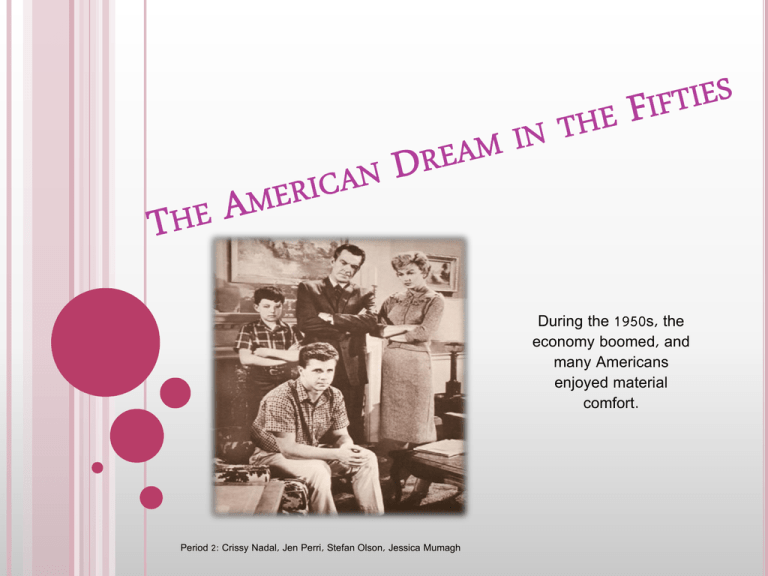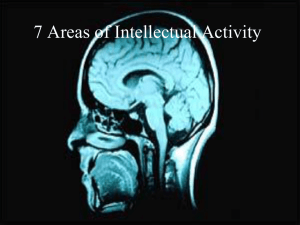19_2 The American Dream in the Fifties
advertisement

During the 1950s, the economy boomed, and many Americans enjoyed material comfort. Period 2: Crissy Nadal, Jen Perri, Stefan Olson, Jessica Mumagh THE ORGANIZATION AND THE ORGANIZED MAN -1950’s businesses expanded rapidly - More people worked in higher paid, “white collar” positions CONGLOMERATES - conglomerate- a major corporation that includes a number of smaller companies in unrelated industries - Many white-collar workers performed services in large corporations and some expanded by forming conglomerates FRANCHISES -Franchises were made to diversify business expansion - Franchise- company that offers similar products or services in many locations - Fast food restraints developed SOCIAL CONFORMITY - Employees in thriving companies sometimes loss individuality for economic advancement: - The Organization Man (1956), by William H. Whyte, described how the new, large organizations created “company people”. - Some companies even gave out personality tests to see if the employee would fit in. THE SUBURBAN LIFESTYLE - Most Americans worked in cities but few of them lived there. - 1950s every large city was surrounded by suburbs.. - Suburbs embodied the American dream THE BABY BOOM - As soldiers returned home from WWII to their families there was an explosion of newborn babies. (baby boom) - 1957 1 baby was born every 7 seconds; total of 4,308, born that year ADVANCES IN MEDICINE AND CHILDCARE - discovery of drugs to fight and prevent childhood diseases. -Dr. Jonas Stalk developed the vaccine for polio -Stalk wrote Common Sense Book of Child Care (1946), which gave parents less abusive ways to take care and discipline their children. -Baby boom impacted the American economy and educational system WOMEN’S ROLES - Role of homemaker and mother was glorified - Carol Freeman spoke of her discontentment of women’s roles in the 50’s; felt isolated, bored and unfulfilled. - Mother with paying jobs rose to 40% LEISURE IN THE FIFTIES - People owned more labor saving devices. (washing machines, dishwashers, etc.) - Many people participated in sports -Americans became avid readers THE AUTOMOBILE CULTURE - Petroleum was imported to make gasoline inexpensive and abundant. - Car sales rose from 6.7 mil (1950) – 7.9 mil (1955) INTERSTATE HIGHWAY SYSTEM - “Automania”-people having to drive long distance to a destination, spurred local and state governments to construct roads linking the major cities to schools, shopping centers, and workplaces. - Interstate Highway Act, which President Eisenhower signed in 1956, authorized the building of a nationwide highway network 41,000 miles of expressways. - This building of highways contributed to the decline in railroads CONSUMERISM UNBOUND - 60% of Americans were middle class - Consumerism- buying material goods, which came to be equated with success NEW PRODUCTS - One new product after another appeared in the marketplace. Examples: TV, casual clothes, household appliances PLANNED OBSOLECENSCE - Manufactures began using a marketing strategy called planned obsolescence - Planned obsolescence- purposely designed products to become obsolete (to wear out or outdated) in a short period of time, therefore urging consumers to be up-to-date. - American culture was becoming a “throwaway society” BUY NOW, PAY LATER - First credit card: Diner’s Club(1950) Second credit card: American Express (1958). - Introduced Home mortgages and car loans - Total private debt grew from $73 billion to $179 billion - Instead of saving money, Americans were spending it, confident that prosperity would continue. THE ADVERTISING AGE - The advertising industry capitalized on this runway consumerism by encouraging even more spending via ads which prompted people to buy goods. - Advertisers tried to convince them to buy things they did not need. - Turned to psychology to create new strategies for selling - Television had become not only the medium for mass transmission of cultural values, but a symbol of popular culture itself. NOTES http://imagesource.allposters.com/images/pic/CLASS/130-114~Leave-it-to-Beaver-Posters.jpg http://cache.viewimages.com/xc/51479225.jpg?v=1&c=ViewImages&k=2&d=E017D84470B84EBED 5B064AE881D1B59284831B75F48EF45 http://www.hud.gov/local/or/images/fha04-astoria1950.jpg http://www.virtualstampclub.com/images/40s-babyboom.jpg http://images.43things.com/entry/240289pw150.jpg http://www.arcind.org/images/56%20chevy%20-%20resized.JPG http://www.wayhome.com/gar/images/forsale/wwd3.jpg http://www.memorystore.org.uk/_images/fashionPics/largepopup/1953fashions.jpg http://pzrservices.typepad.com/vintageadvertising/images/2007/04/30/deborah_kerr_for_lustre_cre me_shamp.jpg http://www.funnyphotos.net.au/images/coca-cola-ads-from-the-1950s1.jpg http://farm1.static.flickr.com/172/394162038_a01778ea0c_b.jpg http://students.umf.maine.edu/~lovejoem/Lucy.jpg QUESTIONS 1) By 1956, most Americans had ________ jobs, which include clerical, managerial, or professional occupations, rather than blue-collar jobs, or industrial jobs. a. red-collar b. white-collar c. yellow-collar d. green-collar 2) Many corporations continued expanding by forming _________, or a major corporation that includes a number of smaller companies in unrelated industries. a. franchises b. businesses c. conglomerates d. ventures 3) Dr. Jonas Salk developed a vaccine for __________. a. polio b. small pox c. measles d. malaria 4) What did the Interstate Highway Act authorize? a. taxes on tobacco to pay for highway repair b. the building of a nationwide highway network c. permitted states to set speed limits d. states to convert freeways to toll roads 5) What is planned obsolescence? a. a marketing strategy in which the manufacturers purposely design products to become obsolete so customers will buy the next new model b. consumer purchasing an item even while knowing it will need to be replaced c. an illegal maneuver by a company to purchase items that will need replacing, benefitting the supplier d. a marketing strategy in which the item is long lasting, but the accessories become quickly useless.





